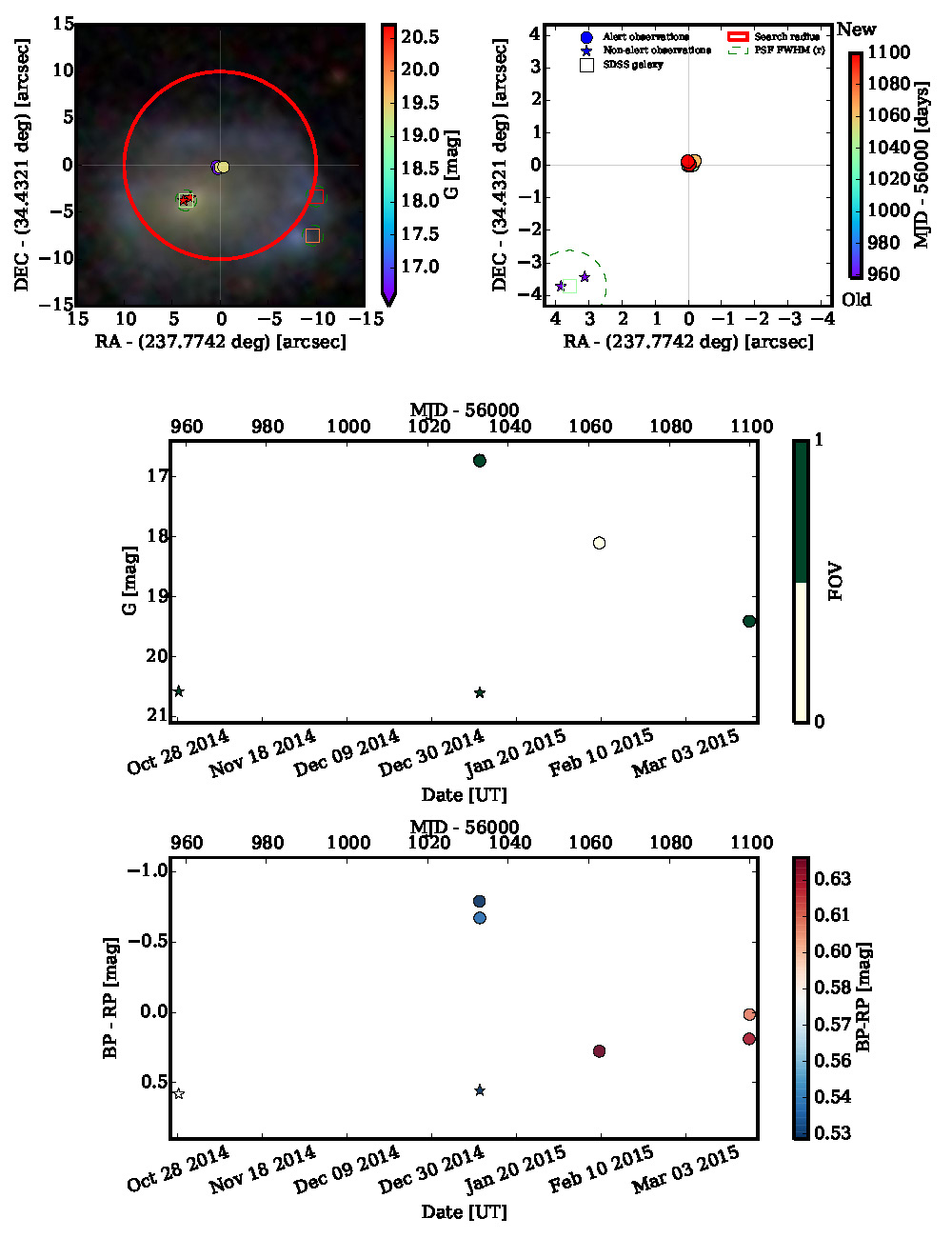|
The discovery of ESA Gaia's first supernova, Gaia14aaa, in September 2014 marked the first Gaia photometric science alert (PSA) published. As of mid-May 2015, more than 240 alerts of transient candidates have been published, including supernovae, cataclysmic variables, active galactic nuclei and M-dwarf flares among others (see Gaia UK website).
Gaia observes some 50 million objects per day of operations, this data being downloaded to ground on a daily basis. Rapid processing is carried out through the Initial Data Treatment (IDT) pipeline, an element of the Data Processing and Analysis Consortium (DPAC) Gaia pipeline. IDT generates a preliminary astrometric and photometric catalogue of all the sources detected by Gaia during that observing period.
Finding the few genuine transients amongst these observations can resemble searching for 'a needle in a haystack'. Putting in place an effective detection pipeline is vital in rapidly detecting and publishing reliable photometric science alerts. DPAC's Photometric Science Alerts team has developed several of these filtering and selection processes that are able to identify potential PSAs.
Although the detection of transient candidates is a largely automated process, a visual inspection is still required as a final step, aiming to weed out spurious alerts. Gaia data alone provides valuable information on the position, brightness and bulk spectral properties of each source. Ancillary catalogues provide additional information about the environment around the transient candidates.
The figure above is an example of a data visualisation chart developed to aid in reconstructing the environment of the transient:
- The top left plot shows all Gaia observations (filled circles) for Gaia15aaj and the nucleus of its host galaxy (filled stars) found within a 10 arcseconds radius around the alerted position. The colour shows the magnitude of each observation. A small scatter has been added to the position of Gaia observations for visualisation purposes. The background shows an image from the SDSS catalogue and the positions for the sources found in the catalogue (empty squares) within a 10 arcseconds radius (large red circle). The dashed green circle shows the apparent angular size of the galaxies (PSF FWHM) in the SDSS "r" band.
- The top right plot is a close up of the Gaia observations only, colour coded by their observed time.
- The plot in the centre shows the light curve of the transient, which allows the evolution of the magnitude (brightness) of the detected sources to be tracked. Some of the observations are separated by a few hours, so they are seen as a single point in the lightcurve.
- The plot at the bottom shows the BP-RP colour for each observation.
The figure describes the following scenario. In mid-October 2014, the galaxy was observed by Gaia. Only the nucleus was detected. The colour of the observation was red and the position agreed with the position of an SDSS known galaxy. At the beginning of January 2015, the galaxy was observed again. In this case, along with the galaxy nucleus, Gaia detected a new blue source at approximately 5 arcseconds away from the previous observation. An alert was raised and published as supernova candidate Gaia15aaj. After the alert, Gaia observed the candidate on two additional occasions, proving that the object was fading with time.
Young supernovae usually display hot emission at around ~10,000K, which provides its characteristic blue colour. As the ejected material in the supernova expands, the detected light becomes dimmer and cooler. This process can be observed in the progressively redder colour of the supernova transits in the BP-RP diagram.
It is expected that, along with a better coverage of the sky and improved filtering techniques, the reliability of transient detections will increase. Visual inspection then will no longer be required to discard false positives, but will rather aid in characterising the environment of each transient. This contextual information will provide additional value to the community, enabling a better assessment to be made as to the scientific value of each published alert.
Credits: ESA/Gaia/DPAC/Photometric Science Alerts Team. The data visualisation work described here was carried out by Nadia Blagorodnova, as part of her GREAT-ITN PhD project, within the context of the DPAC work at the IoA, Cambridge, UK. The photometric science alerts pipeline builds on the Initial Data Treatment pipeline (developed by the DPAC team in Barcelona, with contributions from the teams in Leiden, Edinburgh and Lund) at DPCE and the data ingestion facilities at DPCI.
Acknowledgement: EU FP7 Grant Agreement 264895
[Published: 19/05/2015]
|









































 Sign in
Sign in
 Science & Technology
Science & Technology
